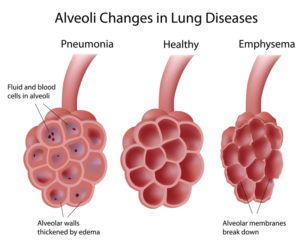What Is Pneumonia?

Your lung contains many tiny sacs that are supposed to fill with air when you inhale. But if you have a lung infection, those tiny sacs can fill up with pus or other fluid instead. Swelling of the tissue that surrounds the air sacs can also make it hard for the air sacs to inflate. This problem is called pneumonia. If a case of pneumonia gets bad enough, you could suffocate. That is why pneumonia has always been a major cause of death.
Fortunately, there are a few simple things you can do to protect yourself against pneumonia. One is to make sure that you get all of your recommended vaccinations, possibly including the pneumonia shot. The pneumonia shot protects against several strains of Streptococcus pneumoniae, which is also called the pneumococcus. Pneumococcal vaccines are given to babies and to elderly people, as well as to anyone else who is at risk for pneumococcal infection. The vaccine is particularly important for protecting people against the antibiotic-resistant strains of pneumococcus.

Streptococcus pneumoniae is a facultatively anaerobic organism. That means that it thrives in an oxygen-rich environment, such as the upper respiratory tract, but can also live in oxygen-poor environments. As a result, it thrives in the human upper respiratory tract, which is its natural habitat. However, it can also invade deeper tissues, such as the bloodstream, heart, joints, bones, and brain.
Since the pneumococcus naturally lives in the human upper respiratory tract, it is just waiting for an opportunity to cause problems. As a result, it often causes pneumonia and invasive infections in the wake of some other illness, such as a cold or a case of the flu. Thus, the influenza vaccine can also help to protect against pneumonia. Lung diseases such as emphysema, which is due to damage to the walls of the air sacs, can also increase the risk of lung infections and death from pneumonia.
To protect itself against the human immune system, the pneumococcus secretes a complex sugar called a polysaccharide. This polysaccharide forms a capsule around the bacterial cell. The capsule makes it hard for a white blood cell to grasp and swallow the pneumococcal cell. The capsule also hides the bacterial proteins. Thus, it makes it harder for the body to recognize the bacteria as a foreign invader. The human immune system can make antibodies against the polysaccharide. However, each strain of pneumococcus has a different polysaccharide. As a result, the antibodies against one strain of pneumococcus will not protect you against a strain with a different polysaccharide capsule.
Why Are There Two Types of Pneumococcal Vaccine?
Two types of pneumococcal vaccine are available. One type is the polysaccharide vaccine, which is made out of the polysaccharides from 23 different strains of pneumococcus. The other type is a conjugate vaccine. It is made by binding the polysaccharides from 13 different strains of pneumococcus to a bit of protein called a conjugate. The purpose of the conjugate is to help the body develop a stronger, longer-lasting immune response, even in children under 2 years of age.
Who Needs the Pneumonia Vaccine?
The pneumococcal conjugate vaccine is routinely given to babies at age 2, 4, 6, and 12 to 15 months of age, as well as to patients age 65 years or older. It may also be recommended for patients age 2 years to 65 years of age if they have certain health conditions. The pneumococcal polysaccharide vaccine is recommended for patients over 65. It may also be recommended for younger patients who are at high risk for pneumococcal infection.

